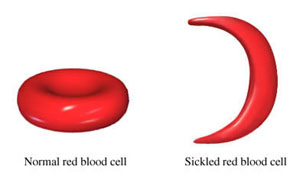Sickle cell disease (SCD) is an inherited condition where the normally round red blood cells of the body necessary for carrying oxygen throughout the body change shape taking on a crescent or “sickle” shape and become sticky—clumping together and blocking blood flow to any area of the body. Approximately 100,000 Americans have sickle cell disease and its most common in adults from specific regions of the world like Africa, Saudi Arabia, India, Greece, Turkey and the Caribbean to name a few.
In the United States, most cases of sickle cell disease are identified at birth when babies receive their newborn screening blood test, but symptoms don’t usually appear until 4 or 5 months of age. Identifying the condition early, through tests offered by companies like Pathway Genomics, may help parents and healthcare providers reduce the complications of sickle cell with lifestyle changes and monitoring but symptoms tend to worsen over time. Here are some of the most common problems people with SCD face:
Hand-foot syndrome: This early sign of SCD causes swelling of the hands and feet as cells change shape and stick in the blood vessels. Hand-food syndrome may also come with a fever. Always see a doctor the first time you notice symptoms and follow their recommendations, but most cases of hand-foot are treated with pain medication and increased fluids.
Sickle cell crisis: As one of the most common causes of emergency room visits and hospitalizations, sickle cell crisis causes pain that may be mild to severe caused by sickled cells that clump together and block blood flow to an area of the body. Pain may be mild or severe and the length of the crisis will vary from person to person. Preventing a crisis will look different for each person, but try to avoid stressing the red blood cells in general. This means avoiding high altitudes or situations with low oxygen (like mountain climbing or flying) or stressing your body with vigorous exercise. Certain lifestyle modifications like not smoking and stress management may also be helpful.
Splenic sequestration: When sickled cells gather in the spleen the organ may quickly enlarge and could be life threatening without treatment. Symptoms of splenic sequestration include rapid breathing, pale lips, thirst, and left sided abdominal pain. Parents of children with SCD should ask their doctor to teach them how to feel the spleen for enlargement and get help if they notice a change.
Infection: People with SCD are susceptible to infections of many types (particularly bacteria) because of damage to the spleen. Pneumonia is the leading cause of death in children with sickle cell. However, since the development of the pneumococcal vaccine, these numbers have been on the decline. Long-term antibiotics may also be prescribed by your healthcare provider and make sure all members of your family practice good hand washing.
Anemia: One of the most common problems, sickle cell disease causes the red blood cells to die earlier than healthy ones—drastically reducing the body’s ability to carry oxygen. Anemia may trigger fatigue, paleness, dizziness, irritability and delayed puberty to name a few. Treatment may include blood transfusions.
Sickle cell disease may cause a spectrum of symptoms. You can find out more about these and their treatment, but there might be more to consider. If you are planning to have a baby, your doctor may have talked to you about screening tests to find out if you or your partner carries the sickle cell trait. This information can help you decide how to move forward with family planning and make the decision that’s right for you and your partner.

